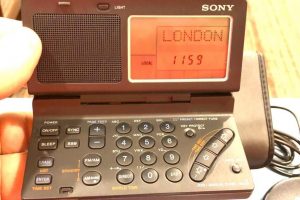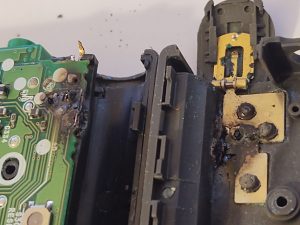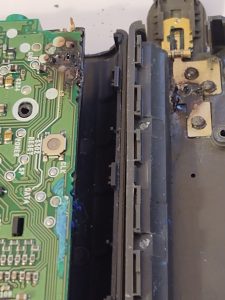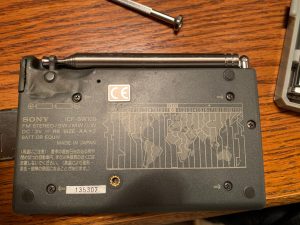WARNING: due to the graphic nature of these photos, those radio enthusiasts who love the Sony ICF-SW100 may want to look away. Parental Discretion is advised.
Guest Post by Troy Riedel
Some of you may remember my recent lamenting regarding the unexpected loss of my beloved Sony ICF-SW100 posted on this blog. The Medical Examiner opened the radio’s chassis last week. The manner of death is rather obvious, but what caused it? Before I reveal my research, allow me to quicky remind you of the context to the situation.
Due to a medical emergency, I “deployed” for two months to tend a remote farm (one of the few benefits was being able to drive a tractor – a kid from my generation grew-up dreaming of piloting heavy construction equipment and farm implements). I traveled there with two shortwave portables: the Sony ICF-SW100s and the XHDATA D-808. After a long day of work, shortwave radio was my only mode of relaxation during my extended period of solitude.
I had always used Eneloop nickel metal hydride (NiMH or Ni-MH) rechargeable batteries in my SW100. I’m not a physics nor a chemistry major (the closest knowledge I have is enough atmospheric physics to have once been a moderately successful synoptic weather forecaster & aviation weather briefer in the military). As such, my education doesn’t directly correlate so I offer an advance apology for my overly simplistic and layperson synopsis of the specific cause & manner of death of my SW100.
I think we all know that a battery is “energy stored inside of a small container”. And energy is heat – measured by random motion (random motion is directly proportional to heat meaning as motion increases or decreases, the heat generated by the motion will do the same).
NiMH & Lithium battery cells have an alkaline electrolyte, usually potassium hydroxide (potash). The electrolyte serves as the catalyst to make a battery conductive by promoting the movement of ions from the cathode to the anode on charge and in reverse on discharge. The electrolyte is sensitive as it has to be to promote charging & to generate power. And the heat that’s produced by the battery can be dangerous because as we previously discussed, a battery is a “closed” container that stores energy … and if we think about it, so is a bomb, right?
Well, the term closed is slightly misleading and not 100% correct. A rechargeable household battery has a vent which acts as an exhaust. This vent allows excess heat to escape. If you Google image search “NiMH battery anatomy”, there are two ways to vent heat. On Panasonic Eneloops and most commercial household batteries, the vent is the rubber puck (disk) under the positive button tab. This disk seals the internals (thus the term “closed”) while also permitting excess heat to [generally] safely vent. Some manufacturers actually have multiple exhaust openings (holes) around the button top that act as vents. Regardless of how it’s done, these batteries do have an exhaust or venting system.
To summarize thus far, rechargeable batteries vent excess heat (whether generated during use or during charging) from the top of the battery. Venting heat during charging is critical because as well all know, one does not want to overheat batteries during (re)charging. This is why everyone should use a smart charger. A smart charger is one that monitors the energy level of the battery and shuts-off when it reaches capacity (I learned that capacity is defined differently by different manufacturers but all seem to shut-off somewhere at 90% or greater). I remember the portables that were released maybe 10-15 years ago that introduced charging inside the radio. The very early models were not smart, the user had to either program how many hours you wished to charge the battery/batteries or the radio itself was programmed to charge for x-amount of hours regardless of whether the batteries needed to be charged for that long (you could very easily continue charging for hours after the battery attained 100% capacity – a very dangerous situation for your valuable radio!). Thankfully most newer radios, except the inexpensive “no-frills” radios, have smart changing technology. Regardless, I have never been a fan of using my radio to charge batteries as I’ve always felt this is too dangerous because the process produces heat and I do not want [excess] heat generated (or vented) inside of my radio!
There are typically more shipping restrictions, more transportation restrictions with Lithium batteries than there are for NiMH batteries (I’m sure most people have noticed shipping restrictions when buying electronics regarding the shipment of Lithium batteries – and if shipment is allowed, it’ll cost more to ship because Lithium batteries cannot be shipped via all modes). Lithium (3.7v) & NiMH (1.2v) batteries are essentially the same technology, except Lithium generates more “power” aka “more heat” (3x the voltage) and are thus much more sensitive to heat (including environmental heat) .
In doing my research, I found a slight conflict regarding the stability of NiMH batteries in storage. Some manufacturers warn that NiMH batteries should not be stored in temperatures over 30C (86F) while others list 40C (104F) as the threshold. What happens above this threshold? The electrolyte catalyst is activated, and the battery will generate its own heat (heat that must be vented).
At this point, I’m sure you can see where this is going. I had two NiMH batteries inside of my SW100. The two stacked batteries increased the inherent risk (in a worst-case situation, two batteries would create & release/vent more heat than a single battery). I was in a hot environment, I lacked air conditioning for most of the time, and I had a long drive of nearly 300-miles to/from my location at the start & the end of the two months I was there. My SW100 was apparently put into peril when it encountered environmental [ambient] temperatures that exceeded the Eneloops threshold (30C? 40C?). And this caused the NiMH Eneloops to heat-up beyond normal, vent the excess heat, and thus “melt” part of the PCB and the back case of the SW100.
This did not happen during normal storage of my radio in my temperature-controlled house, but rather it happened in the adverse environment I temporarily subjected the radio to.
Yes, I know … think what you want (but please don’t say it). User error. I should have known better. It was my fault. It was dumb. Yes, yes, yes & yes answer those four statements. I know, I know …
There are three positives to this:
(1) I learned a painful albeit valuable lesson;
(2) Maybe others can learn from my folly; and
(3) Parts to maintain these classics must be salvaged. I donated my radio (including the AC adapter) – it’s not a total loss and it still has value as a “parts radio”. My SW100 is now in the hands of a skilled, master technician who might be able to save the life of another (or multiple) SW100 radio(s).
My loss just might be someone else’s gain? I take comfort that my radio may live on (as an organ donor) to potentially provide years of enjoyment for someone else.
Postscript re: my initial post:
I have picked-up a few of my other shortwave radios since my initial post (PL-390, PL-880, XHDATA D-808, Satellit 750) & I have started listening again.
And I did have surgery a couple of weeks ago for the physical injury I sustained while tending the farm (my ICF-SW100 wasn’t the only casualty during this period of time). After a frustrating 2+ weeks, I’m starting to make progress with my physical healing. And now that I have a definitive answer on the manner & cause of death of my SW100, I’m psychologically healing from that as well.
UPDATE after my initial post:
I neglected to make the following statement: one can debate whether the excessive heat being vented caused the PCB & case to melt, or if the vent(s) in one or both batteries failed, or if the battery heated-up too quickly & too much for it to safely vent? The only thing I do know: the batteries exhibit no physical damage or defect so the exact mechanism of the the excessive heat will remain unknown.





Reviving an old thread… I am in need of a telescoping antenna for a SW100 if anyone knows where one might be found, or a aftermarket ( I found one of the right length, but dia. was to large), or one from another radio that is the same size. I read the SW07 might be the same.
I have 5 SW100s and spare parts are a bit hard to come by.
I have a SW-100 (serial 44691) in great shape – including the leather folio. Mine came with the AN-100a Active-Antenna. (Bought it from the Sunnyvale HRO after getting my first job.)
Later I bought, an extra ribbon cable from Sony, and also the separate AN-100. Might even have the box for the SW-100. I know I do for the AN-100, but the box is pretty beat up.
The poor thing doesn’t get much attention these days, so if someone wants to make an offer I can’t refuse, I won’t. Callsign at Hotmail for email.
Correction: The second antenna is the AN-1. Should not have tried to guess it’s model number from memory. 🙂
Sorry , I passed out after seeing the first autopsy photo……hihi.
Hmmmm
There would be tens of thousands of NiMh powered LED flashlights in hot cars (including my flashlights in my black truck in E NC) that get routinely exposed to much higher temps than 104F without self ignition.
While I won’t say it can’t happen, I’d think it very unlikely . I’m sorry you lost a friend!
Since batteries are the topic here…
Rechargeable Li-ion AA cells are starting to make an appearance and I recently bought a set of four.
Since these Li-ion cells have a higher voltage there’s circuitry engineered into the cell to step-down the voltage to 1.5 volts.
That circuitry emits RF, as I found out when I used these batteries in a pocket radio, making reception on medium wave useless.
So, in addition to all the other RF interference that’s around, it’s now also coming from some batteries.
Hi Troy,
Glad you’re on the mend post-surgery!
All the evidence seems to suggest something went awry with the NiMH cells when your radio was exposed to elevated temperatures.
The only time I’ve had a similar experience was a while back now when I was charging NiMH batteries inside a Uniden scanner. There was a burning plastic smell, on investigation after shutting the power down the battery compartment was partially melted. Lesson learned…
You weren’t charging the batteries of course so that variable doesn’t apply in your case.
Best,
John
KC8RZM
I had one for many years, then i dropped it 9 inches onto a wooden surface and it never worked again
Hi Troy, I felt sorry when I read about your loss and I’m glad to hear you’re on the mend! Whether or not that was all your fault is not clear at all – if the batteries look unharmed it might be more likely that a different part burnt up or there was some excess contact resistance leading to what looks like a little fire on the PCB. Whatever it was, you may have been lucky that it was “only” the radio that burned.
SW100s seem to pop up on eBay and other platforms quite regularly and sometimes the prices are even still comparatively moderate..
I must be clear – my conclusion was my own (the last time I spoke with the “medical examiner”, he was still investigating). I based my conclusion on what I saw in the photos and deep Internet research via message boards, research into the NiMH battery, etc.
Thanks for the positive comments. I will post a clarification, correction or retraction if the “professional” tells me that he found the cause and it contradicts my theory.
…. and remember, despite their supposed ‘superior’ grade, NEVER use Duracell batteries. If left in a unit for a long time they are guaranteed to leak. Check various YouTube videos for others who have found this out under experiments. I lost my beloved Sony ICF-7600D because it was delayed in shipping from Miami to Grenada by 3 months 🙁 It was badly eaten up inside. Oh, don’t trust shipping agents who say their warehouse is air conditioned or their shipping dates!
Paul,
I’ve lost several things with leaking Duracells … mostly low-tickets items like flashlights, and maybe a clock or two? I don’t use Duracell batteries in electronics.
I had wondered if it was just me. The only batteries I’ve had leak over the last couple of years are Duracell’s. They aren’t even more than a year or so old at the time. Duracell is supposed to be a premium battery and they certainly charge a premium price. I haven’t bought Duracell in quite some time due to this.
I generally use Eneloops or Amazon basics rechargeables now. I’ve had good luck with both. For disposable alkalines I always use Rayovacs. They seem to give you the best bang for the buck and I’ve never had one leak.
I’ll add to that Energizer batteries, just don’t ever use them, they’re leakers.
When I use alkaline cells I use Amazon’s own basic brand, I’ve never had one leak (not saying they wouldn’t ever leak, because I think all alkaline batteries have the potential to leak) plus they’re much cheaper than the big brand names and very good value.